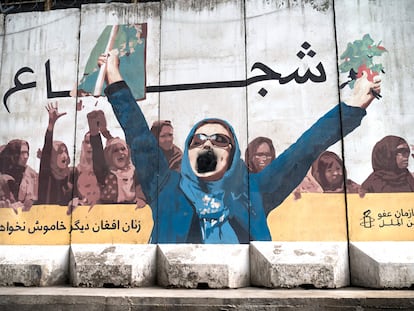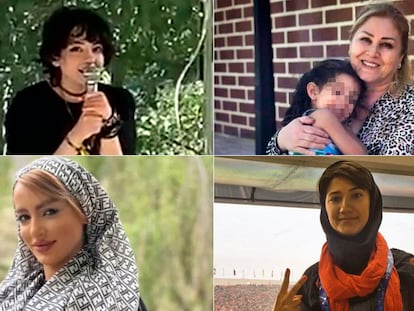Protests in Iran transform into a women-led civil disobedience movement
The growing number of female citizens who refuse to wear the mandatory veil is keeping alive the flame of the demonstrations, which have largely been repressed
Images of the two supreme leaders – who have directed the destiny of Iran for the past 44 years – watch Tehran’s inhabitants from billboards and posters. Few faces are more ubiquitous than those of the late Ayatollah Khomeini and his successor, Ali Khamenei, on the walls of the Iranian capital. The only others that are so widely seen are those of the martyrs from the 1980-1988 war with Iraq.
In the murals that cover this grey city, there is hardly any room for women. When they appear, they’re in the background and, without exception, veiled.
Many Iranian women are breaking with this official image as they walk down the streets with their hair uncovered. This gesture has become the most visible act of civil disobedience in Iran, where the state’s repression has largely succeeded in quelling the demonstrations that were unleashed following the death of Mahsa Amini. The 22-year-old woman was killed at the hands of state security forces in September of last year, after being arrested for allegedly wearing her veil improperly. Not wearing it is a crime in Iran, punishable by jail.
The message of an iconography that erases women – instead paying homage to the two rulers (one dead and one alive) and the martyrdom of those who died in a war – contrasts with the recent mass protests, whose motto has been: “Woman, life, freedom.” These three words have been chanted, above all, by young Iranians, although the cry is now barely audible in Tehran, a megacity with 16 million inhabitants.
However, this chant still resonates in other areas of Iran, such as Kurdistan, in the northwest, and Sistan and Balochistan, in the southeast. In these two regions, ethnic discrimination is added to the list of grievances of protesters, who are calling for “bread and freedom,” as described by Ali Alfoneh, an Iranian political scientist exiled in the United States.
Since January – according to the Critical Threats project, put out by the conservative American Enterprise Institute – the frequency and number of protests has decreased notably. One particular piece of information seems to confirm this trend: the slowdown in the death toll from state repression. According to Iran Human Rights – an organization operating in exile – the protests led to some 500 deaths and an estimated 20,000 detainees.
On February 3, Ali Khamenei promised amnesty to some protestors, on the condition that they show “repentance.” Four young men – all in their twenties – were executed by hanging in Iran between December and January. They were killed after participating in the demonstrations and subsequently being found guilty of murdering members of the security forces, in trials that Amnesty International denounced as “a farce.”
The shadows cast by those young people – some left hanging in public from cranes, blindfolded, with their hands tied behind their backs – could have a lot to do with the decline in the number of protests. This is what Fereshteh (a pseudonym) believes. She is a young Iranian woman in her twenties. This past Wednesday, she walked down the central Vali Asr avenue in Tehran, with her curly hair blowing in the wind. The avenue links the wealthy northern neighborhoods of the city with the economically depressed districts in the south.
“People no longer demonstrate – they’re afraid,” the young woman muses in an alleyway, which she has entered to speak with EL PAÍS.

In Iran, speaking to a foreign journalist without authorization can lead to a person being jailed in Evin, a notorious Tehran-based prison. With dark humor, many Iranians now compare it to a university, due to the sheer number of students who have been detained there in recent weeks.
Fereshteh displays unusual courage but she wells up when she talks about those who “have lost their lives, in the street or on the gallows, just for asking for democracy and freedom.”
The tragic fate of Mahsa Amini echoes in Fereshteh’s story. The young woman emphasizes that she doesn’t wear the veil because it’s the symbol of “a religion that she does not want” and of a “regime that is not good.” She has been arrested three times by the morality police.
Amini was also arrested by this group. The white vans with green stripes – used by the morality police – have left Iranians like Fereshteh with painful memories. However, they are now largely absent from the streets of Tehran on the eve of February 11, the day that commemorates the anniversary of the establishment of the Islamic Republic when 44 years ago the revolution overthrew Shah Mohamed Reza Pahlavi, the country’s last monarch.
“Mahsa was a girl like me. She was visiting Tehran and she must have been afraid, afraid that she would be arrested. I was afraid, too. For me, she is a symbol,” Fereshteh notes.
The gesture of removing the veil – in rejection of laws that many Iranians consider unfair – is not the only one that indicates the defiance exemplified by the protests is still alive. Numerous videos circulated on social media last week detailed how in Tehran neighbourhoods such as Ekbatan, in the west of the city, many residents shout slogans against the regime from their balconies, sheltered in the darkness of night.
Raffaele Mauriello – an Iranologist and professor at the Allameh Tabataba’i University, the country’s largest university for the humanities – believes that the “civil disobedience campaign” that has followed the protests “can be compared to that of the civil rights movement in the United States.” The beginning of the latter occurred during an act of defiance against an unjust law by a woman: Rosa Parks, the Black activist who refused to give up her seat on a bus to a white man in 1955. Like her, the professor emphasizes, the Iranians without hijabs demonstrate “a peaceful opposition that is much smarter than demonstrating in the streets.”
Not far from where Fereshteh dares to challenge the regime without a headscarf is the Kasra hospital: the medical center where Mahsa Amini died after spending three days in a coma after being arrested. Foreign journalists cannot enter the private hospital without permission. In the universities – a nerve centre of the protests – foreign journalists are also banned, explains the translator and driver from the agency designated by the authorities to accompany EL PAÍS. Correspondents from foreign outlets have no choice but to contract this service.
In Iran, there is fear. Maryam – a pseudonym used by a 17-year-old girl – sums it up like this: “If you speak out against the regime, they find you. I don’t know how, but they find you.”
This girl and her four friends are also not wearing headscarves. Before running off to the metro stop near Tehran’s Grand Bazaar, they insist: “It’s not about wearing a scarf or not wearing it. What we want to change are the rules that oppress us and that leave us in inferior conditions. We’re not even asking for the government to change – what we want is for the rules to change.”
In Iran, women inherit half as much as men and can only file for divorce in a few special cases. They automatically lose custody of their children when they turn seven; their testimony is worth half that of a man. Certain powerful positions – such as that of a judge, or the presidency – are forbidden to them.
According to the United Nations, 60% of university students in Iran are women, but they represent less than 20% of the workforce. A 2021 study by Human Rights Watch found that this low presence in the labour market is not unrelated to the subordination of Iranian women to their husbands or fathers, who can prohibit them from working and travelling abroad. This deters many companies from hiring them. In 2015, Nilufar Ardalan – captain of the women’s national soccer team – was unable to compete in a tournament in Malaysia because her spouse forbade her.
Like many other Iranians, the young Fereshteh removed her headscarf for good when the demonstrations began. When asked if she will wear it again one day, she answers in English: “Never!”
Sign up for our weekly newsletter to get more English-language news coverage from EL PAÍS USA Edition










































